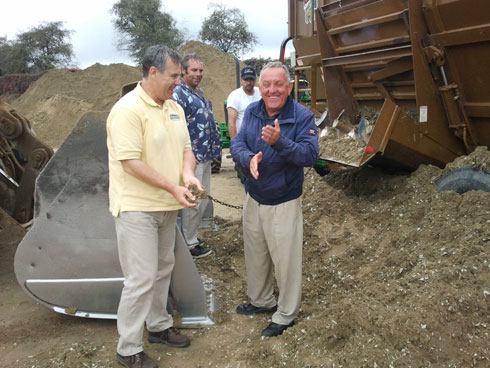New Footing at LAEC
By Staff Report December 1, 2011
George Chatigny, left, and Rudy Leone, prepare to spread new footing at LAEC. (Photo courtesy LEG Up News)
Responding to entreaties from its elite jumper clients, the Langer Equestrian Group has installed high performance footing at the Los Angeles Equestrian Center. The first major event to take advantage of the upgrade was the $50,000 Grand Prix of Los Angeles CSI-W, which utilized the Equidome and adjacent warm-up ring Nov. 19.
LEG CEO Larry Langer lauded “how hard the guys worked to get the footing mixed and laid down so quickly.” The non-slip composite textile footing from German Geo Textiles, known as GGT, was installed under the supervision of Leone Equestrians and Rudy Leone, who became a rep for the Deutch firm after investigating footing for his own six-ring center in Sacramento.
“The horse show business is very competitive. There are multiple shows to choose from on any given weekend,” said Leone, who decided this was an area in which he would excel with his facility and the six A-rated shows he produces each year. “The footing can really make a difference, but it’s pretty pricey. I signed on as a rep so I could buy it wholesale. If you go out and buy it with footing companies that do this as their main line of work, it will cost about three times what it costs if I do it.”
The basic material is the same used at four-star international events from the World Cup to the Olympics, Leone explained, adding that while it’s one thing to purchase the stuff, it’s quite another to prepare and install. “I have six rings so I tried six different mixtures and figured out which was best. The biggest secret is the actual recipe, as well as using the right kind of sand. My recommendation is silica sand – a quartz derivative that is also used to make glass.”
The footing has a number of specific properties. In Europe, where it is common for competitions to take place in the rain, GGT has become known as a great all-weather footing. While mud is not so much an issue on the California show scene (and certainly not in an indoor venue like the Equidome), the moisture resilience was immediately put to the test at the L.A. National. “When all the other rings shut down with the rain, they could still ride in that warm up ring near the Equidome because it was fine. It doesn’t change consistency when wet.”
Fellers, who rode the fancy new footing to a blistering 42.78 second jump-off time for his L.A. National win on Flexible said he found the arena surface improved, but there is still room for improvement. “It’s good-quality material, but when I walked the course it felt a little uneven and I was constantly adjusting my ankles. It was a little lumpy-bumpy. I’m not a footing expert, but I think they can work it differently to smooth it out a little.” (Leone indicated some new grooming equipment was on order.)
While the upgrade has raised questions among the hunter riders as to whether they can expect a similar upgrade to other LAEC rings, Leone points out that as a multi-disciplinary facility, LAEC faces some challenges in grappling with that. “The one thing about this footing is because it’s non-slip it’s not necessarily great for every sport. The polo players tried it and love it, the hunter jumper people love it, but if you get a reiner in there that wants to slide, he’s not going to get a slide out of it.”
For events that emphasize speed, he vows it can’t be beat. “The issue the jumper people have with all-purpose footing is if you want to run fast and make great time your horse is going to slip in the corners. So this is shaping up to be part of the evolution of the sport – changing out the footing for the event.”
“That’s what we’re doing now,” said LAEC general manager George Chatigny. “Right now that footing is in the large oval and large oval warm up areas. We want to be able to adapt to the different types of events that take place here.”
Leone said moving the footing is not as complicated as it sounds, and is about two days’ work. He noted that even for the hunters, for whom time is not as decisive a factor, the high-tech material is advantageous in that it won’t shift or compress at the take-off and landing base of the jump. Those areas are typically worn down to the base after several horses have their turn. “You can put a parking lot on it and it won’t compress,” Leone chuckled. “In my opinion this is the footing of the future,” he said. “Once you have it, you can’t live without it. For the soundness and safety of horse and rider, it’s better than any other surface.”
More information about the Los Angeles Equestrian Center, visit www.la-equestriancenter.com; For more information about the Langer Equestrian Group, visit www.langershows.com/
Short URL: https://theequestriannews.com/?p=7256


